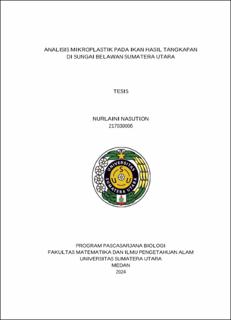Analisis Mikroplastik pada Ikan Hasil Tangkapan di Sungai Belawan Sumatera Utara
Microplastics Analysis in the Gastrointestinal Tract and Gills at Belawan River North Sumatera

Date
2024Author
Nasution, Nurlaini
Advisor(s)
Tanjung, Masitta
Jumilawaty, Erni
Metadata
Show full item recordAbstract
Plastic waste pollution has spread to waters and is currently a serious problem. Plastic in the water will be degraded into microplastics (particle <0.1-5 mm). Research on analysis of microplastics in fish caught in the Belawan River aims to analyze the presence of microplastics based on type, color and quantity in the digestive organs and gills include hematological profile values are erythrocytes, hematocrit and hemoglobin. The research location was divided into five paluh are Paluh Titi, Leman, Harimau, Acin and Serong. Catching the fish was carried out at 07.00-17.00 WIB using a net throwing 32 throws per half for two consecutive days. Microplastic examination was carried out on the digestive organs and gills. Microplastic extraction using KOH and observed under a microscope with a magnification of 10 x 0.25. The research results showed that nine types of fish and three types of microplastic were obtained, such as fiber, fragments and film. The colors of microplastics found in the digestive organs and gills are black, green, blue, orange, red and brown. The presence of microplastics in caught fish has not affected the hematological profile. The paluh where the most microplastics were found was Paluh Titi and the lowest was Paluh Harimau. The highest abundance of microplastics was the Plotosus canius type with an abundance of 12 particles per fish. The lowest abundance of microplastics in Channa striata was around 3.6 particles per individual.
Collections
- Master Theses [261]
